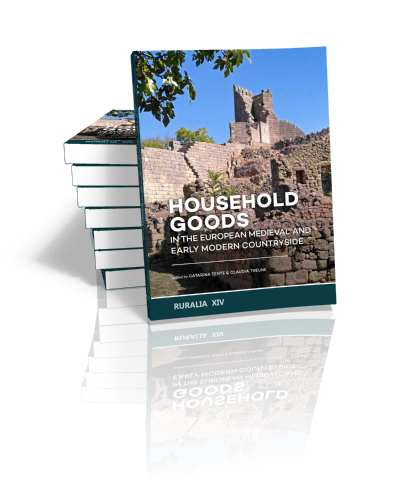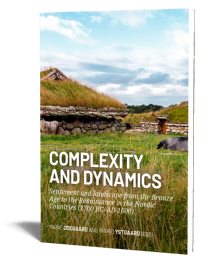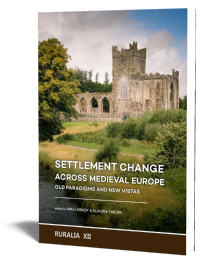Household goods in the European Medieval and Early Modern Countryside
Edited by Catarina Tente and Claudia Theune | 2023

Household goods in the European Medieval and Early Modern Countryside
Edited by Catarina Tente and Claudia Theune | 2023
Paperback ISBN: 9789464270600 | Hardback ISBN: 9789464270617 | Imprint: Sidestone Press Academics | Format: 210x280mm | 276 pp. | Ruralia XIV | Series: Ruralia | Language: English | 12 illus. (bw) | 88 illus. (fc) | Keywords: household goods; medieval; post-medieval; archaeology | download cover | DOI: 10.59641/cd27f3b4
Read online 794 times
- Digital & Online access
-
Buy via Sidestone (EU & UK)
-
Buy via our Distributors (WORLD)
For non-EU or UK destinations you can buy our books via our international distributors. Although prices may vary this will ensure speedy delivery and reduction in shipping costs or import tax. But you can also order with us directly via the module above.
UK international distributor
USA international distributor
-
Bookinfo
Paperback ISBN: 9789464270600 | Hardback ISBN: 9789464270617 | Imprint: Sidestone Press Academics | Format: 210x280mm | 276 pp. | Ruralia XIV | Series: Ruralia | Language: English | 12 illus. (bw) | 88 illus. (fc) | Keywords: household goods; medieval; post-medieval; archaeology | download cover | DOI: 10.59641/cd27f3b4
Read online 794 times

We will plant a tree for each order containing a paperback or hardback book via OneTreePlanted.org.
Although household goods are a well-establish topic in Medieval and Early Modern archaeology, more recent research is overcoming simple typological and technological aspects and pointing to broader approaches, which relates to the understanding of goods’ production, consumption strategies, other economic activities and structures of social organization. Thus, the understanding of past societies and cultures relies heavily in the study of their household goods to understand people, groups and societies.
In this context, the aim of the Ruralia XIV Conference was to emphasize the significance of household archaeology to the study of the European countryside in Medieval and Modern times under a cross-cultural approach. Detailed analysis of single contexts, small parts of sites, faunal, botanical and soil studies enables us to reconstruct common peoples’ activities and interactions within their homes. House functions can be detected by means of specific installations but also by inventories and location of goods, evidence for particular activities inside, such as cooking and eating, storage, weaving, refuse disposal, resting, etc. or by a comprehensive overview of outdoor surroundings.
All this is evidence of functional purposes but it can also tell us about the rank and wealth of their owners, their daily lives, household compositions, family concepts and even gender statuses. Moreover, structural analysis can give evidence about spheres of interaction and patterned behaviours within a house.
In different sections (archaeology and household; temporary households; living conditions; spatial structure; household objects and social and economic status) case studies across Europe are presented.
Foreword and Introduction
Household goods in the European medieval and early modern countryside – an introduction
Catarina Tente, Claudia Theune
Archaeology and Household
Is that all there is? Reflections on the presence and survival of household goods in archaeological contexts
Bert Groenewoudt, Rowin van Lanen
Household goods illuminated by motivation and need theories in Hanfelden Castle in the early modern countryside of Styria, Austria
Iris Winkelbauer, Claudia Theune
Household and home life in the Russian Countryside during the sixteenth to first half of the eighteenth century, according to archaeological finds in Alexandrovskaya Sloboda
Irina Zaytseva
Tenth-century peasant houses and household goods. The potential and limitations of the archaeological record from Beira Alta (Portugal).
Tente, Gabriel de Souza, João LuísVeloso, Catarina Meira
Temporary households
Exploring the “extended” household? Historical landscapes, material culture and building materials at the Monte Fasce settlements, Liguria, Italy (17th-21st c.)
Giulia Bizzarri, Anna Stagno
Household in a settlement dealing with large animal husbandry from the 10-11th century in west Hungary
Ádám Pátkai
Living conditions and household
Making a house a home: odd deposits in ordinary households in later medieval Ireland 1200-1600 AD
Karen Dempsey
Checking-in at the multispecies hotel: Natureculture and the early medieval house
Rachel Brody
Households from early medieval rural settlements in Alto Alentejo (Central Portugal): material culture and social structures
Sara Prata, Fabián Cuesta-Gómez
Spatial structure and household
Refitting the past. The spatial distribution of finds as a key for understanding activities and the use of space in medieval farm buildings in the Northern Netherlands
Jan van Doesburg
Kecskemét-Törökfái-dűlő: structure and topographical elements of an Árpádian-age settlement in the Danube-Tisza Interfluve Region, Hungary
Nikoletta Lukács
Social and economic status and household
Household goods of late medieval peasants in Denmark
Mette Svart Kristiansen
Household goods from excavations at homestead in Kopaniec (Seifershau), Poland
Paweł Duma, Jerzy Piekalski
Contextual value of iron household goods in the late medieval countryside: testimony of the Czech Lands
Tomáš Klir, Martin Janovský, Lucie Hylmarová
Peasant household – noble household: objects and structures. Some remarks on household archaeology of late medieval Hungary
László Ferenczi, Edit Sárosi, Csilla Zatykó
Social inequality and household goods in central Iberia during the early middle ages
Carlos Tejerizo
Lord in the Village: Can houseware and personal equipment indicate the presence of a social class?
Andrej Janeš
Local societies and early medieval domestic economies in the light of the Basque Country archaeological record (8th-10th centuries)
Juan Antonio Quirós Castillo
Particular activities – particular household objects
Pottery in medieval rural households – perspectives of archaeological research in Southern Germany
Rainer Schreg
Household goods for winter travel and leisure in Norway – objects, games and processes of enculturation
Marie Ødegaard, Kjetil Loftsgarden
Household goods of Ottoman soldiers in the rural fortified settlements of the 16th–17th century in Hungary
Ágnes Kolláth, Bianka Kovávs, Gyönyi Kovács, Zsófia Nádai
A sign of wealth or everyday objects? The use of stoneware vessels in medieval and early modern Southern Finland
Tuuli Heinonen
Artefacts of osseous and keratinous materials from the Netherlands – the project
Jørn Zeiler, Marloes J. Rijkelijkhuizen, Marloes, Joyce van Dijk
Prof. Dr. Catarina Tente
Catarina Tente is Professor of Medieval and Rural Archaeology at the Nova University of Lisbon with a focus on early medieval rural communities, rural landscape, mountain landscapes, social archaeology.

Prof. dr. Claudia Theune
Claudia Theune is Professor of Historical Archaeology at the University of Vienna with a focus on contemporary archaeology, on medieval and post-medieval marginal landscapes and on early medieval funeral and social archaeology.
Abstract:
Although household goods are a well-establish topic in Medieval and Early Modern archaeology, more recent research is overcoming simple typological and technological aspects and pointing to broader approaches, which relates to the understanding of goods’ production, consumption strategies, other economic activities and structures of social organization. Thus, the understanding of past societies and cultures relies heavily in the study of their household goods to understand people, groups and societies.
In this context, the aim of the Ruralia XIV Conference was to emphasize the significance of household archaeology to the study of the European countryside in Medieval and Modern times under a cross-cultural approach. Detailed analysis of single contexts, small parts of sites, faunal, botanical and soil studies enables us to reconstruct common peoples’ activities and interactions within their homes. House functions can be detected by means of specific installations but also by inventories and location of goods, evidence for particular activities inside, such as cooking and eating, storage, weaving, refuse disposal, resting, etc. or by a comprehensive overview of outdoor surroundings.
All this is evidence of functional purposes but it can also tell us about the rank and wealth of their owners, their daily lives, household compositions, family concepts and even gender statuses. Moreover, structural analysis can give evidence about spheres of interaction and patterned behaviours within a house.
In different sections (archaeology and household; temporary households; living conditions; spatial structure; household objects and social and economic status) case studies across Europe are presented.
Contents
Foreword and Introduction
Household goods in the European medieval and early modern countryside – an introduction
Catarina Tente, Claudia Theune
Archaeology and Household
Is that all there is? Reflections on the presence and survival of household goods in archaeological contexts
Bert Groenewoudt, Rowin van Lanen
Household goods illuminated by motivation and need theories in Hanfelden Castle in the early modern countryside of Styria, Austria
Iris Winkelbauer, Claudia Theune
Household and home life in the Russian Countryside during the sixteenth to first half of the eighteenth century, according to archaeological finds in Alexandrovskaya Sloboda
Irina Zaytseva
Tenth-century peasant houses and household goods. The potential and limitations of the archaeological record from Beira Alta (Portugal).
Tente, Gabriel de Souza, João LuísVeloso, Catarina Meira
Temporary households
Exploring the “extended” household? Historical landscapes, material culture and building materials at the Monte Fasce settlements, Liguria, Italy (17th-21st c.)
Giulia Bizzarri, Anna Stagno
Household in a settlement dealing with large animal husbandry from the 10-11th century in west Hungary
Ádám Pátkai
Living conditions and household
Making a house a home: odd deposits in ordinary households in later medieval Ireland 1200-1600 AD
Karen Dempsey
Checking-in at the multispecies hotel: Natureculture and the early medieval house
Rachel Brody
Households from early medieval rural settlements in Alto Alentejo (Central Portugal): material culture and social structures
Sara Prata, Fabián Cuesta-Gómez
Spatial structure and household
Refitting the past. The spatial distribution of finds as a key for understanding activities and the use of space in medieval farm buildings in the Northern Netherlands
Jan van Doesburg
Kecskemét-Törökfái-dűlő: structure and topographical elements of an Árpádian-age settlement in the Danube-Tisza Interfluve Region, Hungary
Nikoletta Lukács
Social and economic status and household
Household goods of late medieval peasants in Denmark
Mette Svart Kristiansen
Household goods from excavations at homestead in Kopaniec (Seifershau), Poland
Paweł Duma, Jerzy Piekalski
Contextual value of iron household goods in the late medieval countryside: testimony of the Czech Lands
Tomáš Klir, Martin Janovský, Lucie Hylmarová
Peasant household – noble household: objects and structures. Some remarks on household archaeology of late medieval Hungary
László Ferenczi, Edit Sárosi, Csilla Zatykó
Social inequality and household goods in central Iberia during the early middle ages
Carlos Tejerizo
Lord in the Village: Can houseware and personal equipment indicate the presence of a social class?
Andrej Janeš
Local societies and early medieval domestic economies in the light of the Basque Country archaeological record (8th-10th centuries)
Juan Antonio Quirós Castillo
Particular activities – particular household objects
Pottery in medieval rural households – perspectives of archaeological research in Southern Germany
Rainer Schreg
Household goods for winter travel and leisure in Norway – objects, games and processes of enculturation
Marie Ødegaard, Kjetil Loftsgarden
Household goods of Ottoman soldiers in the rural fortified settlements of the 16th–17th century in Hungary
Ágnes Kolláth, Bianka Kovávs, Gyönyi Kovács, Zsófia Nádai
A sign of wealth or everyday objects? The use of stoneware vessels in medieval and early modern Southern Finland
Tuuli Heinonen
Artefacts of osseous and keratinous materials from the Netherlands – the project
Jørn Zeiler, Marloes J. Rijkelijkhuizen, Marloes, Joyce van Dijk
Prof. Dr. Catarina Tente
Catarina Tente is Professor of Medieval and Rural Archaeology at the Nova University of Lisbon with a focus on early medieval rural communities, rural landscape, mountain landscapes, social archaeology.

Prof. dr. Claudia Theune
Claudia Theune is Professor of Historical Archaeology at the University of Vienna with a focus on contemporary archaeology, on medieval and post-medieval marginal landscapes and on early medieval funeral and social archaeology.
- Digital & Online access
-
Buy via Sidestone (EU & UK)
-
Buy via our Distributors (WORLD)
For non-EU or UK destinations you can buy our books via our international distributors. Although prices may vary this will ensure speedy delivery and reduction in shipping costs or import tax. But you can also order with us directly via the module above.
UK international distributor
USA international distributor
- Browse all books by subject
-
Search all books

We will plant a tree for each order containing a paperback or hardback book via OneTreePlanted.org.
You might also like:
© 2025 Sidestone Press KvK nr. 28114891 Privacy policy Sidestone Newsletter Terms and Conditions (Dutch)








